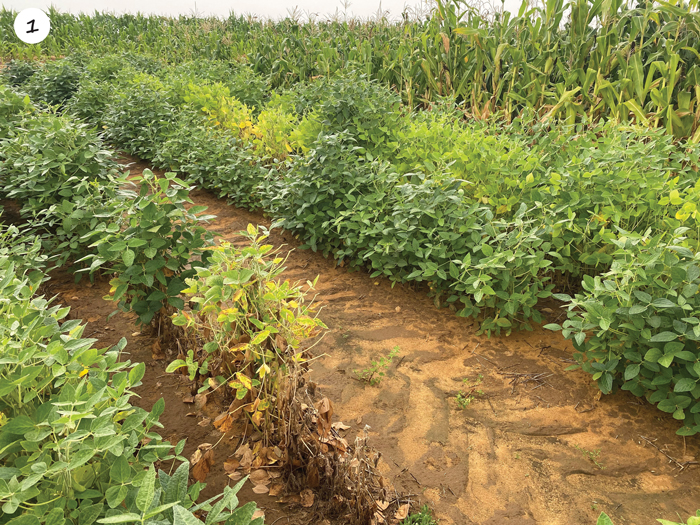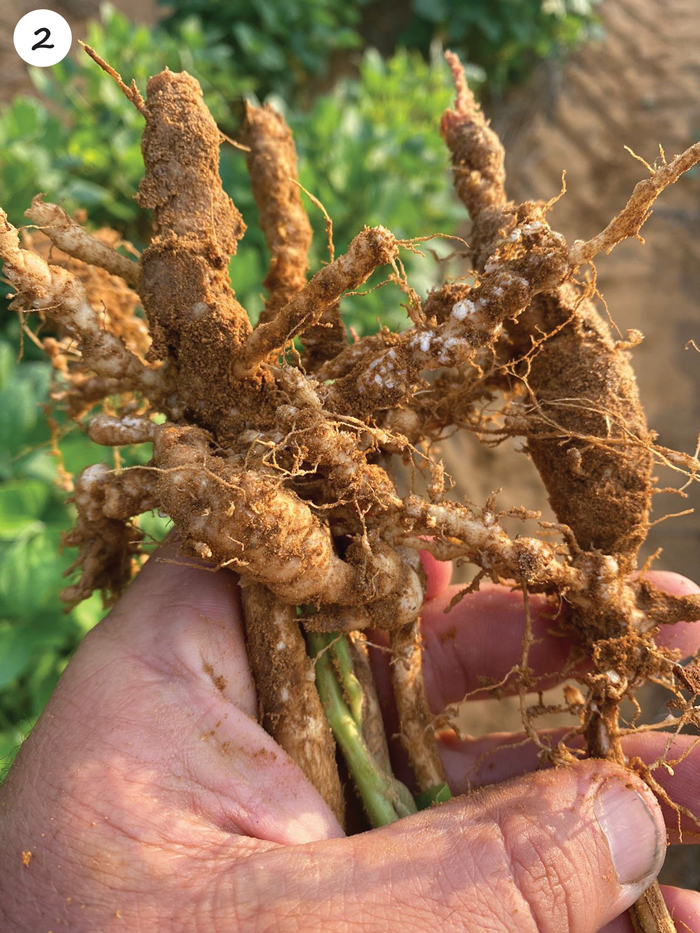
With spring in the air and summer approaching, diseases and pests are likely to emerge and infect summer crops. Pathogenic organisms, such as microscopic, soil-dwelling nematodes, become active as soil temperatures slowly increase after winter.
Once the first spring or summer rains arrive, the increase in soil moisture levels will furthermore favour nematode pests living in the water film around soil particles. Optimal temperature and water conditions allow nematodes to ‘wake up’ from their winter sleep and function at their best. Infective stages of the plant-parasitic or damaging nematode complex will use their reserve energy levels to move in the water layers surrounding soil particles through the soil profile in search of the roots of host plants. Once they reach the roots of such a host, the disease triangle (environment, host, and pathogen) is complete, and feeding by nematode pests starts to inflict damage and yield losses for soybean producers.
Economically important nematode pests
Severe root-knot nematode infection has been experienced in soybean fields during the past few growing seasons. Infected plants within patches of soybean fields ranged from yellowish to stunted, with even some dead plants (Photo 1). The severely galled roots of soybean plants infected with root-knot nematodes in Photo 2, illustrate that such plants cannot take up water and nutrients effectively from the soil. This is an indication of the extent and severity of nematode problems experienced by local producers. This article thus focuses on how and when producers can put various measurements in place to timely identify nematode problems, implement management strategies to reduce nematode pest densities, and be aware of the role that beneficial nematodes can play in soil health and sustainable agriculture.


Reducing plant-parasitic densities should already be a focus point during the colder winter months. Fields left fallow and clean will have fewer plant-parasitic nematodes compared to fields where winter weeds grow. Plant-parasitic nematodes such as root-knot (Meloidogyne) and lesion nematodes (Pratylenchus) locally are the predominant nematode pests of soybean crops and other grains, and they can survive in the roots of volunteer plants such as weeds.
The John Deere-bossie/radiatorbossie is a classic example of a weed in which live root-knot nematode females have been found in the middle of winter in the Free State province. Fallow crop fields covered with this abundant, yellow-flowering weed plants should be a worrisome sight since they host root-knot nematodes that survive in their roots during colder winter months. Such nematode pests have the benefit that they are already ‘seated’ within the roots of weed host plants and will continue their life cycle as soon as soil temperatures rise above the basis levels known for these species. Such temperatures for the two economically most important root-knot nematodes, namely M. incognita and M. javanica that damage grain crops in local production areas, are fairly low: 9,8 °C and 10,6 °C, respectively.
Taking into consideration that a single root-knot nematode female can produce approximately 1 800 eggs (reported for a susceptible soybean cultivar) within 20 to 30 days after infecting the roots of a susceptible host at a soil temperature of 26 °C, population densities of this nematode pest genus will escalate linearly once conditions are optimal for reproduction. The calculation for one female shows that she can produce approximately 5 400 eggs on average during her three-month lifespan. This can lead to exponential growth, especially if soil temperatures are higher, allowing for a shorter period during which more offspring will be produced. This situation is concerning as it can lead to extremely high root-knot nematode population densities before a soybean crop is planted.
Integration of strategies to mitigate nematode damage
Various options are available for soybean producers to protect their crops against nematode damage and are discussed below.
Assessment and monitoring
Knowledge is power, with the assessment and monitoring of nematode populations being key to the successful management of nematode pests in cereal crops. By knowing what type of nematodes are present and in what densities, producers – with the help of trained professionals – can make informed decisions on the implementation of effective management strategies. However, it is important to analyse samples of both soil and root (or other below-ground plant parts such as tubers of potato) since some nematode pests that feed on roots are ectoparasitic while residing in the soil (for example stubby root nematodes).
Other nematodes are endoparasitic and feed while being ‘seated’ or embedded in the roots (females of egg-producing groups such as root-knot nematodes) or migrating (for example lesion nematodes) inside the roots of crops. Producers should hence be pro-active by taking nematode samples for analysis during the preceding crop. While a crop is actively growing, soil and root samples should be taken close to harvesting. This enables precise analysis of nematodes for the following season and is carried out by various nematode laboratories located across South Africa, managed by experts registered with the South African Council for Natural Scientific Professions (SACNASP).
Nematicides
The use of products with nematicide activity is generally the option used by producers to reduce nematode pest densities in soybean fields effectively in the short term. Soybeans (and other rotation crops) should be protected from the seedling stage using registered nematicides according to regulatory guidelines. Accredited consultants and representatives dealing with crop protection products should be consulted for the recommendation of products with nematicidal properties.
Good agricultural practices and other management strategies are important. Producers should always consider and focus on integrating more than one strategy to combat nematode pests. Agricultural practices that support and sustain natural resources (air, soil, and water) as well as non-target organisms (soil- and waterborne organisms, animals, and humans), are being increasingly utilised to effectively control nematode pests. In recent years the implementation of such practices has gained popularity to improve soil health and build resilience against pests and diseases, and the detrimental effects of climate change. This is largely the goal of producers who implement conservation and regenerative agriculture systems and apply, for example, reduced or no-tillage, permanent soil cover, and crop rotations.
From a pest management perspective, improving soil health has the benefit of creating a favourable habitat for predators that naturally help control pests such as nematodes. Nematode predators that feed on other nematodes (known as nematode pests) are present in local soils, but their population is generally low. This is because their life cycles are significantly longer than those of nematode pests. As a result, it takes longer for nematode predator populations to increase to levels where they can effectively control nematode pests in the soil. Increasing organic matter as well as the diversity and numbers of soil microbes can contribute towards mitigating nematode damage to soybean and rotation crops because of optimised ecosystem services.
In addition, utilising genotypes of rotational crops and cover crops that are poor or non-hosts of nematode pests will further contribute positively to reducing nematode pest densities. It is important to understand that the recovery of soil health can take many years to achieve. Also, the implementation of conservation or regenerative agriculture systems should be implemented with care and the help of experienced producers and trained professionals.
Raising awareness
Local producers should continuously be informed about nematode problems experienced in soybean-based rotation systems in which sunflower, maize, potato and other crops are included. The saying that ‘prevention is better than cure’ is also applicable in terms of nematodes and their roles in and impact on local cropping systems. The more knowledge producers can gather about nematodes – both the beneficial/good and plant-parasitic/bad ones – the better they will be equipped to manage them and prevent their population densities from building up to levels that become difficult to manage.
Producers should also aim to understand the roles and contributions of nematodes in agriculture since the presence of beneficial nematodes can contribute towards enhanced ecosystem services that are supportive of sustainable crop production.
Nematode management strategy
- Assessing and continuously monitoring plant-parasitic nematode populations are vital to an effective management strategy. Soil and root samples should ideally be collected while crops are actively growing (and as close to harvesting as possible) and sent to an accredited nematode diagnostic laboratory for analysis.
- Controlling weeds timeously and effectively is crucial and will help to mitigate nematode problems. This is a crucial step towards the sustainable production of crops in the presence of low nematode pest densities since complete eradication of nematode pests are not possible.
- Nematode management is vital for soybean producers because these microscopic microorganisms can cause great yield losses if left unmanaged. Effective nematode management strategies involve crop rotation, using nematode-resistant crop genotypes, maintaining good soil health, and using nematicides. Using these strategies, producers can decrease nematode damage and improve overall crop productivity – and contribute towards food security.



























